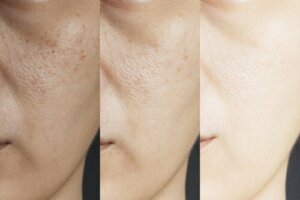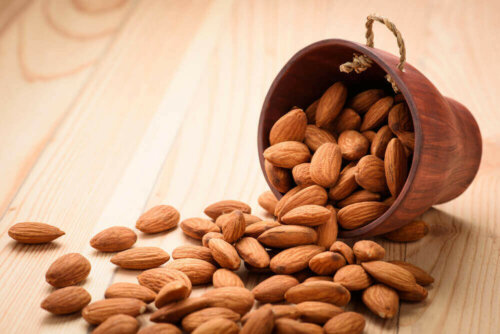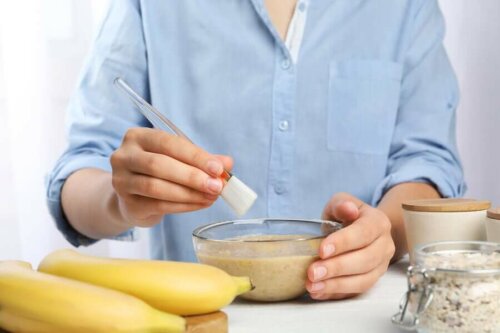Eight Homemade Remedies to Shrink Enlarged Pores


Reviewed and approved by the doctor Karla Henríquez
How to shrink enlarged pores is a major concern for men and women alike. While benign, they’re often considered unsightly. However, contrary to what many think, there is no treatment that can close them.
In fact, as dermatologist Valentin De Benito Rica points out in his blog, pores cannot be opened or closed, although there are some ways to improve their appearance. Thus, when we talk about “sealing the pores”, we’re only referring to a way to clean them so that they aren’t so noticeable.
What can you do to shrink enlarged pores?
According to a publication in the journal Dermatologic Surgery, the treatment of enlarged pores depends, to a large extent, on the factors associated with their development. Thus, the dermatologist could suggest one treatment or another depending on possible underlying causes such as:
- Excessive sebum
- Decreased elasticity around pores
- An increased volume of hair follicles
Topical retinoids, chemical peels, oral antiandrogens, lasers, and other processes that may be helpful for this cosmetic problem are now available. However, each case must first be evaluated by a dermatologist.
Natural remedies to shrink enlarged pores
However, there are some natural remedies that can also contribute to the cleansing of enlarged pores to give the skin a fresher and softer appearance. They are solutions that lack scientific evidence but have been used since ancient times as allies of skin health.
Therefore, there is anecdotal data that suggest that they leave the skin free of impurities and dead cells. Include them in your regular beauty routine and see for yourself if they cause benefits against enlarged pores.
See also How to Make a Good Homemade Face Mask to Clean Your Pores
1. Egg and oat mask
The ingredients in this remedy act as an exfoliant, which can help remove impurities from the enlarged pores. Oats have antioxidant and anti-inflammatory properties that aid in skincare, as detailed in a review published in the Indian Journal of Dermatology, Venereology & Leprology.

Ingredients
- 1 egg white
- 2 tbsp of oats
Instructions
- Beat the egg white and add the oats
- Once you obtain a well-mixed paste, apply to your previously washed face
- Then make circular movements to exfoliate
- Rinse with warm water
- Finally, repeat its use twice a week
2. Cucumber mask
In popular culture, cucumber is one of the most widely used natural ingredients for skin beautification. Its applications aren’t supported by evidence but it’s definitely nutritious and you can use it safely on your skin.
According to a publication in the Fitoterapia journal, cucumber contains antioxidants that can soothe skin irritation. It’s also useful for shrinking large pores and reduces their appearance.
Ingredients
- 1 cucumber
- 2 tbsp of cornstarch
Instructions
- Peel the cucumber and process in a blender. You could also grate it very finely
- Then add the cucumber and cornstarch to a container
- Mix to form a thick paste
- Apply to your face, previously washed, with circular movements
- Let sit for 15 minutes and rinse with warm water
- Use a moisturizing cream afterward
3. An almond mask can shrink enlarged pores
Nuts contain vitamin E, a nutrient with an antioxidant effect that helps skincare. According to a publication in the Indian Dermatology Online Journal, vitamin E helps to protect the skin against the negative effects of the sun and free radicals.
As we mentioned above, decreased elasticity is one of the causes of enlarged pores. Therefore, this type of treatment is quite good. In addition, it also helps to remove impurities that accumulate in the pores when used as an exfoliant.

Ingredients
- 1/2 c. of almonds
- 3 tbsp of water
Instructions
- Powder the almonds
- Mix it with the water to form a paste
- Then, apply it to your face with circular movements, starting with your nose and moving towards your cheeks, forehead, and chin
- Let it sit for 20 minutes and wash with warm water
- Repeat twice a week
4. Tomato lotion
Recent research published in Skin Pharmacology and Physiology suggests that tomato phytonutrients help protect the skin against UV rays. In addition, being rich in water, it is ideal for moisturizing, softening, and cleansing pores.
- All you have to do is apply homemade tomato juice to your face with a cotton ball after showering.
- Repeat every night.
5. Milk whey
A little whey can help remove impurities from the surface of the skin according to anecdotal data. In fact, it’s a good option to shrink enlarged pores and blackheads.
- Apply a bit of whey with a cotton ball after washing your face and before going to bed
- Then, let it sit for 20 minutes and rinse with warm water
- You can do the same but with natural (sugarless) drinkable yogurt if you don’t have whey
Check out this article The Amazing Benefits of a Yogurt and Lemon Mask
6. Banana mask
Cosmetics often use ripe bananas as an ally to moisturize and beautify the skin. Its regular application helps cleanse it and reducing the oily appearance resulting from enlarged pores.

Ingredients
- 1 tbsp banana
- 2 tbsp of warm water
Instructions
- Firstly, incorporate the banana and water into a mixing container
- Then, mix it into a homogeneous paste
- Then, apply it to your face with circular movements to exfoliate
- Finally, let it sit for 20 minutes and then, rinse it with cold water
7. Papaya mask
A publication in the West Indian Medical Journal found that papaya can help promote the healing of skin lesions. There’s not enough evidence about its effects on the skin; although, some anecdotal data recommends it for softening and cleansing the skin.
- Firstly, rub the inner side of the papaya skin over your face
- Then, let it sit for 15 minutes and then, wash it off with warm water
8. Honey mask
Honey is an ingredient described in many dermatology studies. Research published in the Asian Pacific Journal of Tropical Biomedicine says it’s good for skin health due to its antibacterial and anti-inflammatory properties.
Ingredients
- 1 tbsp of oats
- 2 tbsp of honey
Instructions
- Firstly, add the oats to a container and pour the honey slowly
- Mix well to get a homogeneous grainy paste
- Then, apply to your clean, dry face, starting with your nose and forehead
- Continue with your cheeks and don’t forget your chin
- Finally, let it sit for 15 minutes and rinse with warm water
The key is to shrink enlarged pores
There’s no magic formula for sealing dilated pores; in fact, it is not possible to close them. What we can do is keep the complexion clean to minimize its appearance. Thus, try them and choose the one you like the most in order to enhance the look of your skin.
All cited sources were thoroughly reviewed by our team to ensure their quality, reliability, currency, and validity. The bibliography of this article was considered reliable and of academic or scientific accuracy.
- Lee, S. J., Seok, J., Jeong, S. Y., Park, K. Y., Li, K., & Seo, S. J. (2016, March 23). Facial pores: Definition, causes, and treatment options. Dermatologic Surgery. Lippincott Williams and Wilkins. https://doi.org/10.1097/DSS.0000000000000657
- Dong, J., Lanoue, J., & Goldenberg, G. (2016). Enlarged facial pores:An update on treatments. Cutis, 98(1), 33–36.
- Pazyar, N., Yaghoobi, R., Kazerouni, A., & Feily, A. (2012, March). Oatmeal in dermatology: A brief review. Indian Journal of Dermatology, Venereology and Leprology. https://doi.org/10.4103/0378-6323.93629
- Mukherjee, P. K., Nema, N. K., Maity, N., & Sarkar, B. K. (2013, January). Phytochemical and therapeutic potential of cucumber. Fitoterapia. https://doi.org/10.1016/j.fitote.2012.10.003
- Groten K, Marini A, Grether-Beck S, et al. Tomato Phytonutrients Balance UV Response: Results from a Double-Blind, Randomized, Placebo-Controlled Study. Skin Pharmacol Physiol. 2019;32(2):101–108. doi:10.1159/000497104
- Hewitt, H., Whittle, S., Lopez, S., Bailey, E., & Weaver, S. (2000). Topical use of papaya in chronic skin ulcer therapy in Jamaica. West Indian Medical Journal, 49(1), 32–33.
- Mandal MD, Mandal S. Honey: its medicinal property and antibacterial activity. Asian Pac J Trop Biomed. 2011;1(2):154–160. doi:10.1016/S2221-1691(11)60016-6
This text is provided for informational purposes only and does not replace consultation with a professional. If in doubt, consult your specialist.








